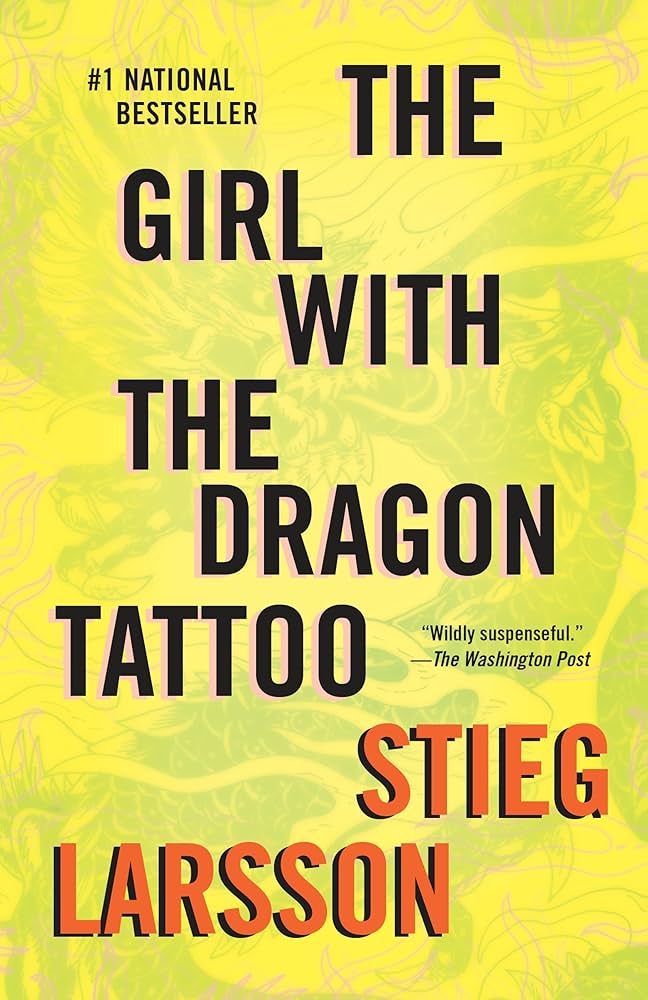The Girl with the Dragon Tattoo Book: A Comprehensive Exploration

Stieg Larsson’s The Girl with the Dragon Tattoo, the first book in the Millennium series, has captivated millions worldwide with its intricate plot, compelling characters, and exploration of social and political issues. This article delves into the various facets of this literary phenomenon, examining its genres, authorial background, cultural impact, and the ways it continues to resonate with readers and viewers.
Genre and Literary Context
The Girl with the Dragon Tattoo defies easy categorization, blending several genres seamlessly. It’s primarily a crime thriller, driven by a complex murder investigation that spans decades. The narrative is meticulously plotted, with twists and turns that keep the reader guessing until the very end. The investigative process itself is a significant element, showcasing the detailed work of both the journalist Mikael Blomkvist and the hacker Lisbeth Salander. Their contrasting personalities and methods make for a dynamic and engaging partnership.
Beyond the crime thriller aspects, the novel incorporates elements of mystery, with the central mystery of Harriet Vanger’s disappearance acting as a catalyst for the unfolding events. The investigation gradually uncovers layers of family secrets and institutional corruption, adding depth and complexity to the narrative.

The novel also touches on political thriller elements, exposing the dark underbelly of corporate power and its influence on society. The story highlights the systemic corruption within Swedish society and challenges the reader to consider the ethical implications of corporate greed and cover-ups.
Furthermore, The Girl with the Dragon Tattoo can be seen as a psychological thriller. The characters are deeply flawed and complex, with troubled pasts that significantly influence their actions. Lisbeth Salander’s character, in particular, is a study in psychological complexity, grappling with trauma and navigating a deeply patriarchal society. Her vulnerabilities, combined with her exceptional intelligence and skills, create a fascinating character arc that resonates with readers.

Finally, subtle elements of romance are interwoven throughout the story. The unconventional relationship between Blomkvist and Salander, despite their initial antagonism, adds another layer of complexity and intrigue. The evolution of their partnership transcends the purely professional, suggesting the potential for emotional connection and mutual understanding.
This multifaceted approach to genre contributes significantly to the novel’s lasting appeal. Its ability to seamlessly blend elements of crime, mystery, psychological and political intrigue, and even romance, ensures a rich and immersive reading experience that caters to a broad range of literary tastes.
Authorial Insights: Stieg Larsson and His Influences
Stieg Larsson, the author of The Girl with the Dragon Tattoo, was a Swedish journalist and investigative reporter who dedicated his life to exposing right-wing extremism and social injustices. This dedication deeply informed his writing, with the Millennium series reflecting his strong social conscience and political views.

Larsson’s journalistic background is evident in the novel’s meticulous research and detailed portrayal of investigative journalism. The story’s realistic depiction of the investigation process, including the meticulous gathering of evidence and the challenges faced by journalists in uncovering the truth, resonates with readers due to its grounded realism. His commitment to fact-checking and rigorous reporting shines through, adding to the novel’s authenticity.
His political activism is clearly visible in the novel’s critical exploration of corporate corruption and the abuse of power. The Vanger family saga serves as a powerful metaphor for the insidious nature of unchecked corporate power and the devastating consequences it can have on individuals and society as a whole. Larsson’s commitment to social justice and equality heavily influenced the narrative, shaping the core themes and driving the storyline.
While Larsson’s personal experiences clearly shaped the narrative, the novel’s success also stems from its universality. The themes of injustice, abuse, and the search for truth are timeless and transcend specific cultural contexts. The exploration of complex characters and relationships, as well as the meticulously crafted plot, contributes to its cross-cultural appeal.
The author’s tragic death shortly before the publication of his trilogy only amplified its impact, turning him into a posthumous literary icon whose work continues to inspire conversations about social justice, corruption, and the power of investigative journalism.
Reading Habits and the Educational Value of “The Girl with the Dragon Tattoo”
The Girl with the Dragon Tattoo has become a widely discussed book, prompting various analyses of its reading habits and literary merit. Many readers appreciate its fast-paced narrative and suspenseful plot, consuming it in short bursts over a few days. Others approach it more deliberately, savoring the intricate details and the complex development of characters. This book’s popularity has generated widespread discussion online, in book clubs, and other informal settings, leading to a range of interpretations and perspectives.
The educational value of the novel is substantial. It offers a compelling case study in investigative journalism, demonstrating the complexities and challenges involved in uncovering the truth, especially when powerful forces are involved. The novel also serves as a valuable lesson in researching and collecting evidence meticulously.
Furthermore, it provides valuable insights into the psychological impact of trauma and abuse. The character of Lisbeth Salander, a victim of severe abuse, is a particularly powerful example of the lasting psychological consequences of trauma. The novel’s exploration of Salander’s character arc reveals her resilience and her struggle to overcome her past, demonstrating the importance of empathy and understanding towards trauma survivors.
The novel also provides social commentary on several critical issues, including corporate corruption, sexism, and violence against women. The story powerfully illustrates the ways in which corporate greed and power can be used to exploit and harm individuals. By examining the dynamics of power imbalances and social inequalities, the book fosters discussion and critical thinking regarding these social issues.
In conclusion, Larsson’s The Girl with the Dragon Tattoo is not only a gripping thriller but also a thought-provoking exploration of several crucial themes. Its accessibility and page-turning quality make it ideal for various reading preferences, while its complexity offers layers of depth and insight to reward those seeking a more analytical engagement with the text.
Cultural Impact and Adaptations
The immense success of The Girl with the Dragon Tattoo has had a profound cultural impact. It sparked a global interest in Scandinavian crime fiction, leading to a surge in the popularity of other Nordic noir novels and film adaptations. The book’s success also elevated the profile of female protagonists in crime fiction, particularly Lisbeth Salander, who became a cultural icon for her strong, unconventional personality, independent nature, and willingness to challenge authority.
The novel has been adapted into several successful films and television series, further enhancing its cultural influence. The 2011 Swedish film adaptation, starring Noomi Rapace as Lisbeth Salander, achieved international acclaim, while the 2011 American remake, featuring Rooney Mara in the same role, generated considerable discussion and debate. These adaptations introduced the characters and themes of the Millennium series to a vast international audience, leading to increased interest in the original novels.
Beyond film adaptations, The Girl with the Dragon Tattoo has inspired graphic novel adaptations, further expanding its reach and allowing new creative interpretations of the story. The different versions, such as the one by Sylvain Runberg, offer unique perspectives and styles, allowing for diverse aesthetic and narrative interpretations of Larsson’s work. These various adaptations contribute significantly to the book’s global popularity.
The enduring appeal of Larsson’s work reflects its universal themes and its ability to connect with audiences on multiple levels. The combination of crime thriller excitement and social commentary continues to engage and intrigue readers and viewers, ensuring its place in popular culture.
Libraries and Archival Significance
Given the immense popularity and critical acclaim of The Girl with the Dragon Tattoo, the novel holds significant archival importance. Copies of the original publication and subsequent editions, translations, and adaptations are likely found in major libraries worldwide, including both physical and digital archives. These resources provide crucial historical context regarding literary trends, genre development, and cultural shifts. Research scholars and literary critics are interested in the book for analyzing thematic elements, narrative techniques, and character development.
The book’s popularity has also led to the creation of various associated materials and fan communities. These digital archives showcase fan-made content, reviews, and discussions, representing a significant aspect of the novel’s cultural impact and long-term preservation. Academic institutions may house primary source materials related to Larsson, offering additional insight into his life and influences, providing a deeper understanding of the novel’s origins and motivations.
Public libraries play a crucial role in making The Girl with the Dragon Tattoo accessible to a wider audience, particularly those with limited access to books and online resources. These resources provide diverse platforms for readers to engage with this cultural phenomenon, and the ongoing discussion surrounding this book will ensure its continued presence in collections worldwide for many years to come. Rare books collections may hold first editions or unique printings of the novel, offering opportunities for analysis and scholarly research regarding early critical receptions and the book’s initial impact.
In conclusion, The Girl with the Dragon Tattoo transcends the boundaries of a simple crime thriller. Its nuanced characters, gripping plot, and powerful social commentary have ensured its lasting cultural relevance, impacting reading habits, inspiring numerous adaptations, and solidifying its place within literary archives worldwide. The novel’s continued popularity underscores its significance as a piece of literature that engages with readers on intellectual, emotional, and social levels.